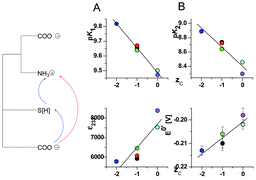Structure–function relationships in glutathione and its analogues
Abstract
The results are presented of measurements of protonation constants (

* Corresponding authors
a
Faculty of Chemistry, University of Wrocław, F. Joliot-Curie 14, 50-383 Wrocław, Poland
E-mail:
arti@wcheto.chem.uni.wroc.pl
Fax: +48 71 3282348
Tel: +48 71 3757264
b
Institute of Biochemistry and Biophysics, Polish Academy of Sciences, Pawińskiego 5a, 02-106 Warsaw, Poland
E-mail:
wbal@ibb.waw.pl
Fax: +48 22 6584636
Tel: +48 22 6597072 ext. 2353
The results are presented of measurements of protonation constants (

 Please wait while we load your content...
Something went wrong. Try again?
Please wait while we load your content...
Something went wrong. Try again?
A. Krężel and W. Bal, Org. Biomol. Chem., 2003, 1, 3885 DOI: 10.1039/B309306A
To request permission to reproduce material from this article, please go to the Copyright Clearance Center request page.
If you are an author contributing to an RSC publication, you do not need to request permission provided correct acknowledgement is given.
If you are the author of this article, you do not need to request permission to reproduce figures and diagrams provided correct acknowledgement is given. If you want to reproduce the whole article in a third-party publication (excluding your thesis/dissertation for which permission is not required) please go to the Copyright Clearance Center request page.
Read more about how to correctly acknowledge RSC content.
 Fetching data from CrossRef.
Fetching data from CrossRef.
This may take some time to load.
Loading related content
